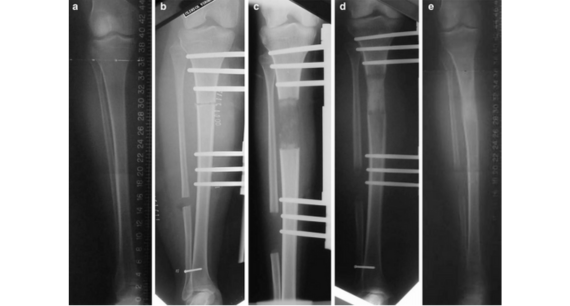Callotasis as a Bone Elongation Method
Callotasis, also known as distraction osteogenesis, is a surgical technique that prompts bone regeneration through gradual mechanical distraction. Following a controlled osteotomy, a distraction device,commonly an external fixator is applied. This initiates a sequence of healing phases where mechanical tension stimulates new bone formation in the gap between bone segments.
This technique is used widely in orthopedics, podiatry, and craniofacial surgery to address limb length discrepancies, congenital deformities, traumatic or oncologic bone defects, and more. Its success lies in leveraging the body’s natural bone healing mechanisms in a controlled, reproducible manner.
Time to Surgery
Timing is critical in callotasis. While non‐biological factors may influence surgical scheduling, optimal results are often seen when the procedure is performed during adolescence,typically between ages 7 and 16,because it maximizes growth potential and minimizes compensatory deformities.
Factors to Consider in Elongations
Successful lengthening demands meticulous planning and attention to numerous variables:
Mechanical alignment and radiographs: Whole-leg standing radiographs are essential to assess mechanical axes, limb discrepancies, and to guide osteotomy placement
Thresholds for surgical correction: Limb length differences under ~2 cm often don’t require surgery. Callotasis is typically reserved for 5–6 cm discrepancies or cases involving short stature
Patient-specific risks: Deformity correction, soft tissue condition, joint instability, spasticity, smoking, irradiated bone, coagulation issues, and psychological readiness,all play a key role.
Fixator choice: Monolateral frames are simpler and less bulky; circular frames (e.g., Ilizarov) provide multi-plane correction and are preferred for complex deformities.
Phases of Callotasis

Latency Phase
After osteotomy, a latency period (typically 5–10 days) allows for hematoma organization, early callus formation, and revascularization. This phase mirrors the early stages of physiologic fracture healing and sets the stage for successful distraction.
Distraction Phase
Once early callus is confirmed radiographically, distraction begins—usually at a rate of ~1 mm/day, divided into multiple increments (e.g., 0.25 mm every 6 hours).The applied tension drives new bone formation, but pace must be tailored based on patient response. Radiographs are taken weekly or monthly to monitor progress, adjust rates, and detect complications 。
Neutralisation (Consolidation) Phase
Once the target length is reached, distraction is halted and the fixator is locked. Full weight-bearing is encouraged to stimulate callus ossification and maturation. The device remains in place until radiographs confirm solid corticalization.
Dynamisation Phase
In the final phase, controlled axial loading is introduced—either through dynamic fixator settings or removal of rigid components—to encourage cortical thickening and prevent stress shielding. This enhances bone remodeling and prepares the regenerate for safe fixator removal.
Summary
Callotasis is a powerful, versatile method for bone lengthening that orchestrates bone regeneration in a controlled manner. Key to its success are:
Precise timing, typically in young patients to reduce compensatory deformities.
Comprehensive preoperative planning, including biomechanical alignment, patient health status, and psychological readiness.
Careful management of each phase:latency, distraction, consolidation, and dynamisation,to optimize bone healing and reduce complications.
In the hands of multidisciplinary teams and experienced surgeons, callotasis achieves transformative outcomes—restoring mechanical integrity and biological harmony to the skeletal system.